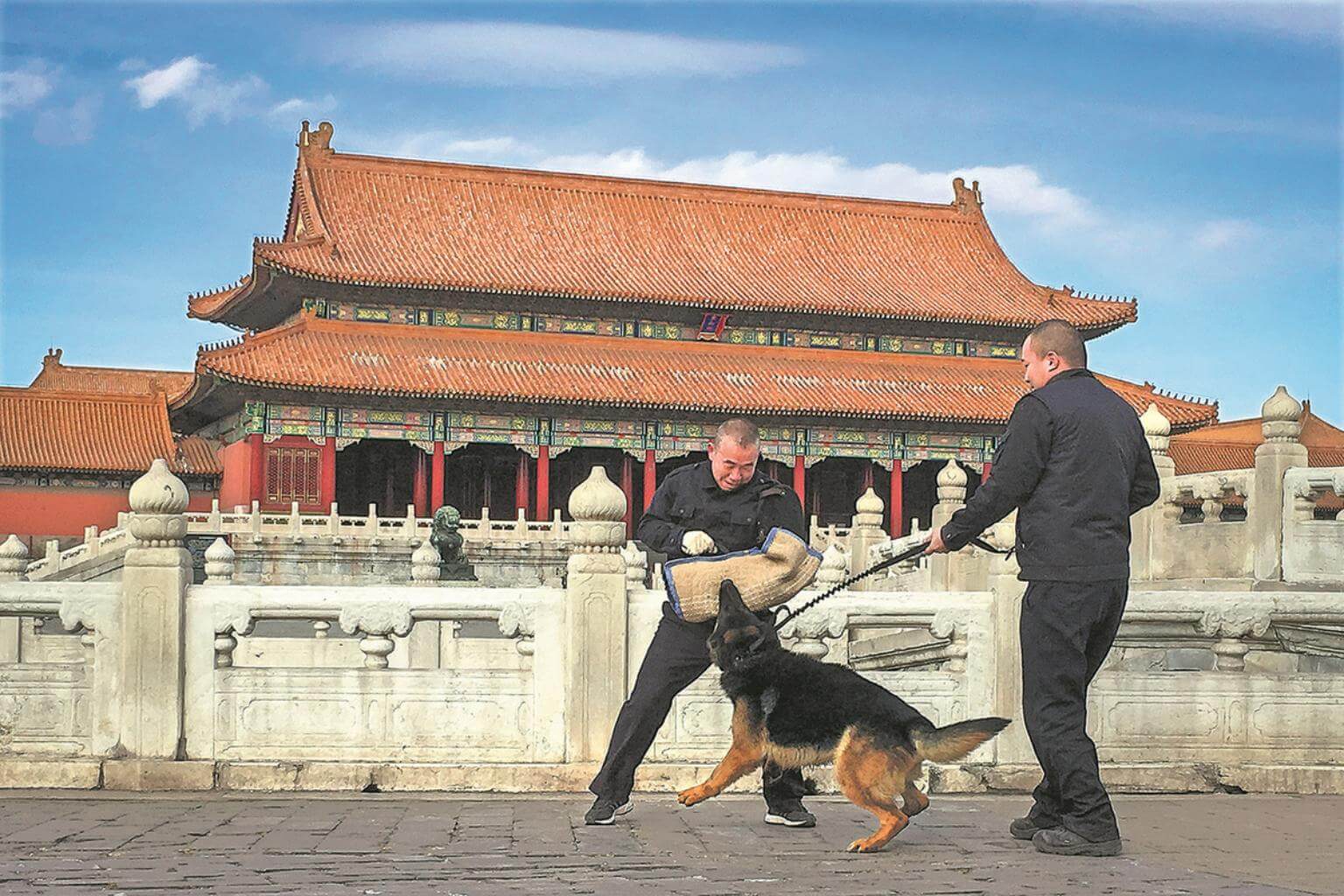Toughest guards of Beijing's Palace Museum have uncanny speed, vicious bite
Sign up now: Get insights on Asia's fast-moving developments

Chang Fumao (left) and Zhang Yu, members of the Palace Museum's canine patrol squad, training a guard dog at the museum in Beijing.
PHOTO: CHINA DAILY/ASIA NEWS NETWORK
Follow topic:
BEIJING (CHINA DAILY/ASIA NEWS NETWORK) - While the Year of the Dog is approaching, on a recent Monday at Beijing's Palace Museum, it appeared it was already here.
A chorus of 23 barking dogs that erupted as a stranger stepped into the museum's kennel did not sound like a Chinese New Year celebration or a warm welcome, however. These dogs help guard a huge hoard of national treasures every night.
The museum, the nation's imperial palace from 1421 until the fall of the Chinese monarchy in 1911, houses as many as 1.86 million cultural relics. The collection of this single museum accounts for 42 per cent of the whole country's "registered national-level precious cultural relics".
Mr Chang Fumao, 59, heads the five-person canine patrol squad. His office, also his bedroom, is hidden near the western gate of the palace complex. Before night falls, visitors and the rest of the museum staff leave. Mr Chang and his colleagues are most familiar with the shadowy face of the ancient complex, where they are on duty from dusk to dawn.
Mr Chang started work helping monitor the museum when he was 20. In the 1980s, the human guards had the help of only sound detectors in the exhibition halls. When something abnormal was heard, they would rush to the scene in case there was a burglar.
"Sometimes, I felt terrified checking the empty and dark palaces alone," Mr Chang recalled. There are many folk legends about supernatural phenomena, like haunted spirits, in the Forbidden City at night, he said.
A guard dog was a welcome addition. A German shepherd named Tiger became his buddy for night patrol.
"I've loved raising dogs since I was very young," he said. "Tiger also gave me courage at first."
But there was a ban on large dogs in downtown Beijing at that time, and the museum was not an exception. Tiger was sent to the countryside.
Shortly after that, a burglar sneaked into the palace.
"My colleagues were very close to catching the burglar," Mr Chang said. "They watched him climb over the wall."
Mr Chang suggested organising a canine patrol squad at the museum and, in 1987, dogs came back.
He became not only a dog trainer, but also headmaster of a puppy "kindergarten". He chose four-month-old puppies, most selected from the countryside or police stations, and began his young wards' "preschool education".
"That's how you can find each dog's talent," he said. "Some are particularly good at fetching a ball from a long distance. That means they are good at tracing. Some have the keenest sense of smell, and some of the more energetic ones like biting things."
At one year old, each dog is given a tailored training course. Most start their career as guard dogs after three months of intense training.
"Chasing and biting abilities are among the most valued characteristics of the dogs because they are trained that the burglar is the top enemy," Mr Chang said.
At 4.30am, Mr Chang rises to give the dogs their morning practice. The entire Forbidden City is their training ground. They must finish before 7am, when some other museum employees start work.
After 5.30pm, when the palace gates are closed, more training commences as the dogs warm up for their nighttime shifts. It is a separate world that many museum employees, let alone visitors, do not realise exists.
The Forbidden City is the world's most visited museum - it had some 16.7 million visits in 2017 - and it is not always easy to make sure everyone obeys the rules. The museum also is immense, at 720,000 sq m.
The dogs occasionally find people who have hidden in the museum at night, but the rule-breakers are generally released without charge if they have not stolen or broken anything.
"If I caught a burglar, I would become really famous," Mr Chang said. "However, at least we've prevented potential accidents and saved national treasures from being damaged. That's the most important thing, right?"
They always have to remain vigilant. In 2011, in the museum's most recent theft, a burglar stole seven pieces of historic treasure from a temporary jewellery exhibition. He was later caught and all the lost items were recovered. Now, a guard dog is assigned to every courtyard with a temporary exhibition to keep an even closer watch on exhibits.
The museum also has a video surveillance system that leaves no angles unseen, according to Mr Shan Jixiang, the museum's director.
"We now have a comprehensive security system combining people, dogs and machines," he said. "We have chubby cats all over the palace but dogs are the unseen animal heroes."
Mr Chang praised the canines as well. "People get sleepy, and machines sometimes malfunction. But the dogs are alert even when they're sleeping. They are the most reliable line of defence."
Guard dogs for the former imperial palace retire at age seven, when it is possible they may be "unable to catch up with a young person in their 20s at full speed", Mr Chang said. They spend their last years at the museum, and a few currently among the group are retirees.
Mr Chang also will retire in 2019. He worries that few young people will be willing to take his place, but the other four humans in the squad are younger than Mr Chang.
"This job is about being bitten," he said. "It's common in training to get hurt by mistake. I cannot remember how many rabies vaccines I've had. But, I love dogs and have raised dogs all my life, which is good enough," he said.

